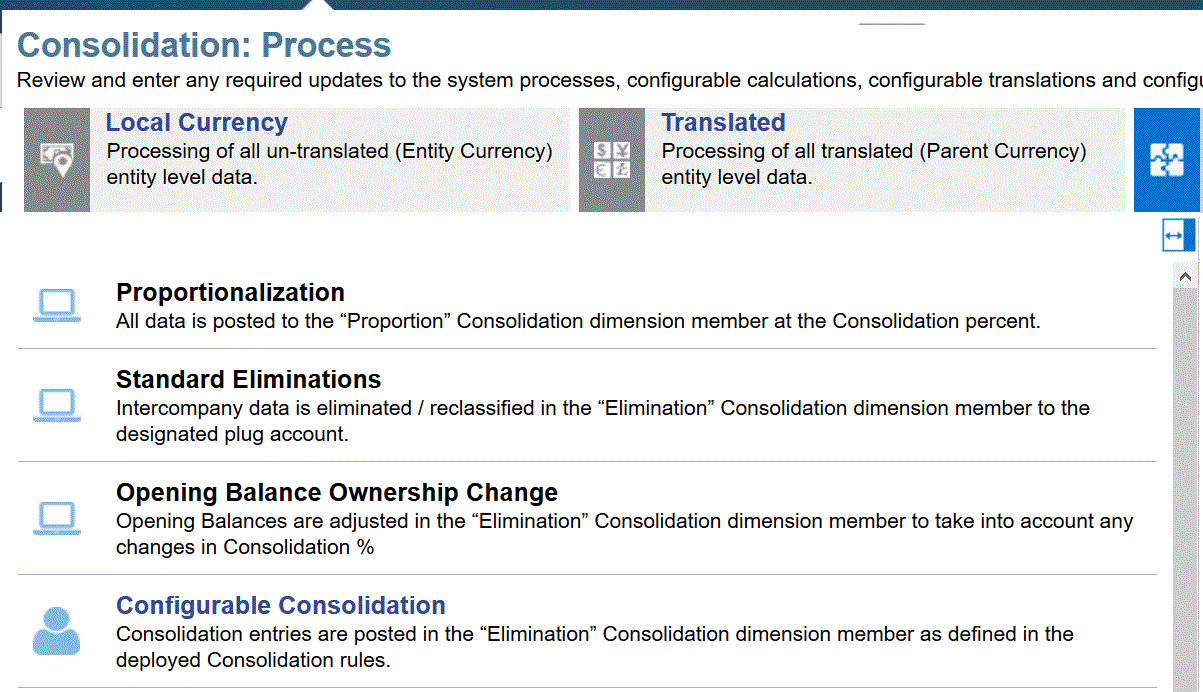Advanced Consolidation Rules
Financial Consolidation and Close will proportionalize all source data, populating the Proportion Consolidation dimension member. The source data is proportionalized at the Consolidation % defined for the parent/child entity combination.
Configurable consolidation rules are used to generate additional entries to populate the Elimination Consolidation dimension member. The Proportion and Elimination members aggregate to the Contribution member. The source data comprises the same data set as is proportionalized. See About Configurable Consolidation Rules.
There are two system consolidation rules that will always run in addition to optional configurable consolidation rules. While system consolidation rules cannot be modified by the user, configurable consolidation rules can be created, modified, activated (deployed) and deactivated (un-deployed). Several seeded configurable consolidation rules are provided.

Standard Elimination Consolidation Rules
The system standard elimination rules are based on account dimension settings and the point-of-view of entered data. These elimination rules will reclassify relevant data to a clearing (plug) account such that the data offsets with similar data from other entities.
For example, Accounts Receivable data recorded by entity A with an Intercompany Partner of entity B should offset Accounts Payable data recorded by entity B with an intercompany partner of entity A. In order for this offset to occur, the Accounts Receivable and Accounts Payable accounts must be set as Intercompany and a common Plug account must be assigned.
Data for either of these accounts is considered for elimination if the Intercompany partner of the data is a descendant of the parent of the entity currently being processed. If the conditions are met, then a two-sided entry is posted to the Elimination Consolidation dimension member. The first entry is a "reverse proportionalization". Data is posted to Elimination with a negative value of the original source data-point multiplied by a Consolidation %. The Consolidation % applied is the lower of the entity Consolidation % and the partner Consolidation %. The source data was proportionalized (to the Proportion member) at the entity Consolidation % so the net effect of the elimination entry is to reverse all or part of the proportionalized entry. The balancing entry is then posted to the plug account in the Elimination Consolidation dimension member. The net effect of this two-sided entry is to re-classify all or part of the intercompany data from the original account to the plug account.
The reclassified data is then aggregated to the Entity Consolidation member of the parent entity. If matching entries are aggregated from both the Accounts Receivable and Accounts Payable accounts then at Entity Consolidation of the parent entity, the net data value will be zero. If mismatched amounts are reclassified and aggregated, then the data value in the plug account at Entity Consolidation will represent the mismatch.
In an organization structure with shared entities, the aggregation of elimination entries processed in relation to each of the branches in which the shared entity resides is not always the result required when all instances of the shared entity are combined. For example, an entity might be owned at 40% by one immediate parent and 40% by another, with the Equity method being applied in both cases. The lower of the entity and partner consolidation % is applied to the elimination. In this case, no eliminations occur because the Consolidation % for the Equity method is 0%. When the two shared entities consolidate into their first common parent however, the combined ownership is 80% and the Subsidiary method should be applied, with a Consolidation of 100%. An adjustment is made at the first common parent at which the aggregated results of the lower level eliminations are incorrect for the current consolidation method. This adjustment is made in the Entity Elimination Adjustments Consolidation member of the first common parent.
Opening Balance Ownership Change Consolidation Rules
Ownership Management introduces the ability to change the Ownership % and the Consolidation Method for an Entity/Parent combination on a period-by-period basis. With a change in Ownership % and/or Consolidation Method, the Consolidation % can also change from period-to-period.
Opening Balance is always carried forward from Closing Balance of the prior period for each Consolidation dimension member. Opening Balance is not proportionalized. Opening Balance therefore represents the prior period proportionalization at the prior period Consolidation %. All other movements aggregating to Closing Balance are proportionalized at the current period Consolidation %.
In order to ensure that the Closing Balance of the current period reflects the Consolidation % of the current period, an adjustment is posted to reflect the change in Consolidation% of the unconsolidated prior period Closing Balance. If the change in the Consolidation % is greater than zero, the entry is posted to "Acquisitions", and if the change is less than zero, the entry is posted to "Disposals".
For entities where the consolidation percent has changed from the last period, FCCS_Mvmts_Acquisitions or FCCS_Mvmts_Disposals are calculated automatically for the Elimination member of the Consolidation dimension in accounts that are eliminated via plug accounts. Any accounts that are eliminated by customer specific rules (configurable consolidation rules or insertion point rules), the customer/partner must write the Opening Balance Ownership Change adjustment and they will populate FCCS_Mvmts_Disposals_Input/FCCS_Mvmts_Acquisitions_Input.
Note that the seeded Movement members "FCCS_Mvmts_Acquisitions" and "FCCS_Mvmts_Disposals" are for system use only and any data entered to these members will be cleared. Members "FCCS_Mvmts_Acquisitions_Input" and "FCCS_Mvmts_Disposals_Input" can be used for data entry, Configurable Calculation (Insertion Point) Rules or Configurable Consolidation Rules.